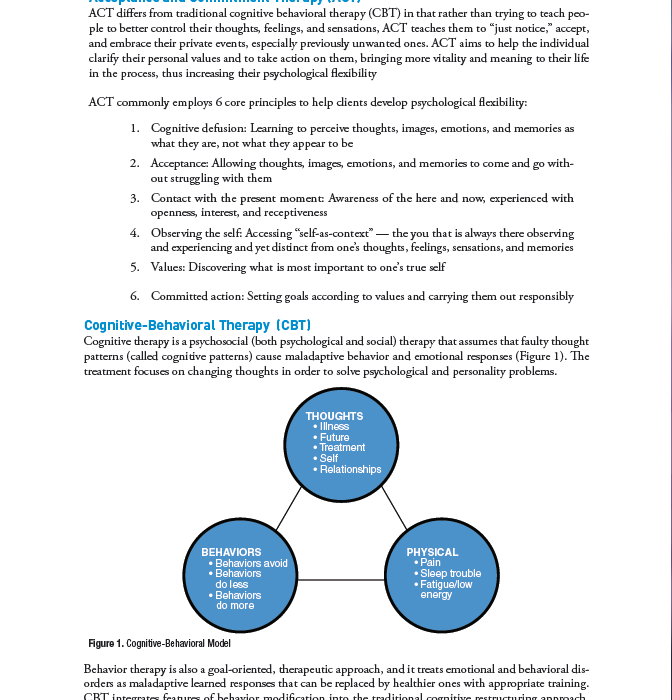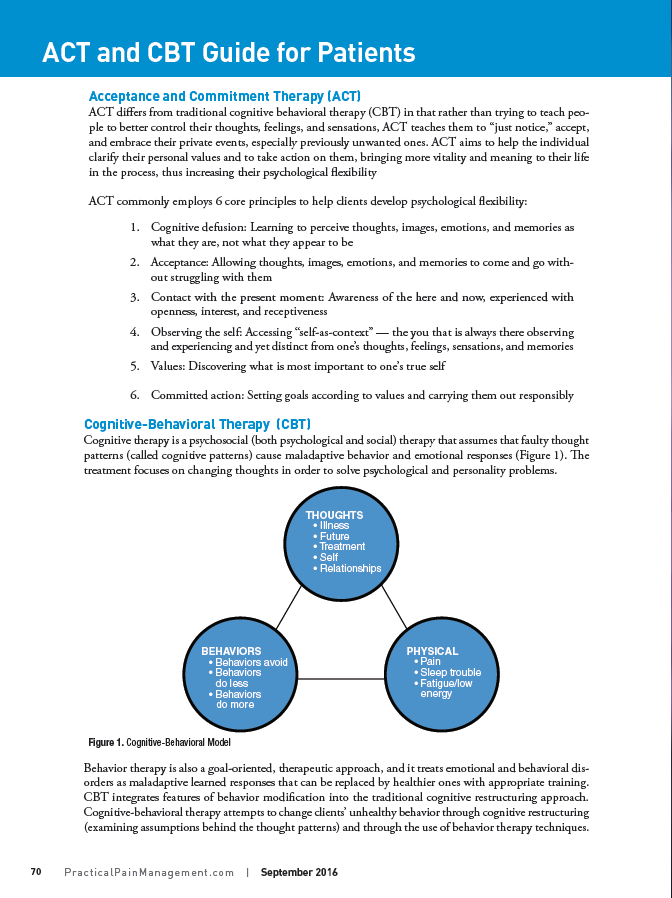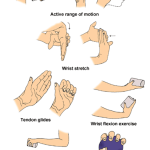If you’ve ever experienced chronic pain, you know how it can affect every aspect of your life. It can make even the simplest tasks feel like monumental challenges. That’s why finding effective pain relief is crucial. One approach that has gained recognition in recent years is cognitive-behavioral therapy (CBT). But what exactly is the role of cognitive-behavioral therapy in pain relief? Let’s explore this topic and see how CBT can help alleviate pain and improve quality of life.
When it comes to pain relief, many people immediately think of medications or physical therapies. However, cognitive-behavioral therapy takes a different approach. It focuses on the connection between our thoughts, emotions, and behaviors, and how they influence our perception of pain. By addressing these psychological factors, CBT aims to change the way we think and respond to pain, ultimately reducing its impact on our lives. In this article, we will delve deeper into the principles of cognitive-behavioral therapy and discuss its effectiveness in managing chronic pain. So, buckle up and get ready to discover a new perspective on pain relief!
What is the Role of Cognitive-Behavioral Therapy in Pain Relief?
Cognitive-behavioral therapy (CBT) is a widely recognized therapeutic approach that focuses on the connection between thoughts, emotions, and behaviors. It aims to help individuals identify and change negative patterns of thinking and behavior that contribute to their pain experience. In recent years, CBT has gained attention for its effectiveness in managing chronic pain conditions. This article explores the role of cognitive-behavioral therapy in pain relief and how it can be a valuable tool in managing and improving the quality of life for individuals living with chronic pain.
The Impact of Chronic Pain
Living with chronic pain can be debilitating, affecting every aspect of a person’s life. It can lead to physical limitations, emotional distress, and a decrease in overall well-being. Traditional approaches to pain management often focus solely on physical interventions, such as medication or surgery. While these methods can provide temporary relief, they may not address the underlying factors that contribute to the pain experience. This is where cognitive-behavioral therapy comes in.
Understanding Cognitive-Behavioral Therapy
CBT is a form of psychotherapy that aims to help individuals identify and change negative patterns of thinking and behavior. It is based on the idea that our thoughts, emotions, and behaviors are interconnected and can influence our overall well-being. In the context of chronic pain, CBT helps individuals develop coping strategies to manage their pain more effectively and improve their quality of life.
The Role of Thoughts in Pain Perception
One of the key principles of CBT is the recognition that our thoughts can influence our perception of pain. Negative thoughts and beliefs about pain, such as catastrophizing or expecting the worst, can intensify the pain experience and make it more difficult to cope. CBT helps individuals identify these negative thought patterns and replace them with more realistic and helpful thoughts. By changing the way we think about pain, we can change the way we experience it.
Changing Behaviors to Manage Pain
In addition to addressing thoughts and beliefs, CBT also focuses on changing behaviors that contribute to the pain experience. This may involve implementing strategies such as pacing activities, setting realistic goals, and practicing relaxation techniques. By modifying behaviors that exacerbate pain or hinder recovery, individuals can regain control over their lives and improve their overall well-being.
The Benefits of Cognitive-Behavioral Therapy for Pain Relief
CBT has been shown to be effective in reducing pain intensity, improving physical functioning, and enhancing psychological well-being in individuals with chronic pain. It provides individuals with the tools and skills they need to manage their pain more effectively and regain control over their lives. By addressing the underlying factors that contribute to the pain experience, CBT offers a holistic approach to pain management that goes beyond temporary symptom relief.
Enhancing Coping Skills
One of the primary goals of CBT is to enhance coping skills. Individuals learn how to identify and challenge negative thoughts, develop relaxation techniques to manage pain flare-ups, and implement problem-solving strategies to overcome obstacles. These coping skills empower individuals to take an active role in their pain management and improve their overall well-being.
Promoting Emotional Well-Being
Chronic pain can take a toll on mental health, leading to feelings of depression, anxiety, and frustration. CBT helps individuals develop strategies to manage these emotional challenges and improve their overall emotional well-being. By addressing the emotional impact of pain, individuals can experience a greater sense of peace and contentment in their lives.
Tips for Incorporating Cognitive-Behavioral Therapy
If you are considering incorporating cognitive-behavioral therapy into your pain management routine, here are a few tips to get started:
1. Seek Professional Guidance
It is important to work with a licensed therapist who specializes in cognitive-behavioral therapy for pain management. They can provide guidance, support, and personalized strategies to address your specific needs.
2. Practice Mindfulness
Mindfulness is a key component of CBT and involves bringing your attention to the present moment without judgment. Engaging in mindfulness exercises, such as meditation or deep breathing, can help you cultivate awareness and reduce stress.
3. Challenge Negative Thoughts
When negative thoughts arise related to your pain, challenge them by asking yourself if they are based on facts or assumptions. Replace negative thoughts with more realistic and positive ones.
4. Implement Relaxation Techniques
Incorporate relaxation techniques, such as progressive muscle relaxation or guided imagery, into your daily routine. These techniques can help reduce muscle tension and promote a sense of calm.
5. Set Realistic Goals
Set realistic goals for yourself and break them down into manageable steps. This can help you regain a sense of control and accomplishment, even in the face of pain.
In conclusion, cognitive-behavioral therapy plays a vital role in pain relief by addressing the connection between thoughts, emotions, and behaviors. It helps individuals develop coping strategies, challenge negative thoughts, and implement behavior changes that contribute to a better quality of life. By incorporating CBT into your pain management routine, you can take an active role in your well-being and experience long-term relief from chronic pain.
Key Takeaways: What is the role of cognitive-behavioral therapy in pain relief?
- Cognitive-behavioral therapy (CBT) is a type of therapy that can help manage and reduce pain.
- CBT focuses on changing negative thoughts and behaviors related to pain, promoting positive coping strategies.
- CBT can teach individuals skills to manage pain, such as relaxation techniques and problem-solving skills.
- CBT can also address emotional factors, such as depression or anxiety, that may contribute to pain perception.
- CBT is often used in combination with other pain management techniques for more effective results.
Frequently Asked Questions
How does cognitive-behavioral therapy (CBT) help with pain relief?
Cognitive-behavioral therapy (CBT) is a type of psychotherapy that focuses on the connection between thoughts, feelings, and behaviors. When it comes to pain relief, CBT can be highly effective in helping individuals manage and reduce their pain levels. CBT works by helping individuals identify and challenge negative thought patterns and beliefs about pain, which can contribute to increased pain perception and intensity. By changing these negative thought patterns, individuals can experience a reduction in pain and an improvement in overall well-being.
In addition to addressing negative thoughts, CBT also helps individuals develop healthy coping strategies to manage pain. This can include relaxation techniques, stress management skills, and problem-solving strategies. By learning these skills, individuals can better manage their pain and improve their quality of life. CBT also focuses on behavioral changes, encouraging individuals to engage in activities that promote pain relief and well-being. Overall, CBT provides individuals with tools and strategies to effectively manage and reduce pain.
Is cognitive-behavioral therapy effective for all types of pain?
Cognitive-behavioral therapy (CBT) has been found to be effective in managing various types of pain, including chronic pain conditions such as fibromyalgia, arthritis, and migraines. However, it is important to note that CBT may not be the sole solution for every individual experiencing pain. The effectiveness of CBT can vary depending on factors such as the individual’s willingness to engage in therapy, the severity and underlying cause of the pain, and the presence of any coexisting mental health conditions.
CBT is typically used as part of a comprehensive pain management approach, which may include other interventions such as physical therapy, medication, and alternative therapies. It is important for individuals to work closely with healthcare professionals to determine the most appropriate treatment plan for their specific needs.
How long does cognitive-behavioral therapy take to provide pain relief?
The duration of cognitive-behavioral therapy (CBT) for pain relief can vary depending on several factors, including the severity and complexity of the pain condition, the individual’s response to therapy, and their commitment to the treatment process. In general, CBT for pain relief is a short-term therapy that typically lasts anywhere from 6 to 20 sessions.
During these sessions, individuals will work with a therapist to identify and challenge negative thought patterns, learn coping strategies, and make behavioral changes to better manage their pain. It is important to keep in mind that CBT is not a quick fix and may require ongoing practice and application of learned skills outside of therapy sessions. With consistent effort and engagement in therapy, individuals can experience significant pain relief and improvements in their overall well-being.
Are there any potential side effects of cognitive-behavioral therapy?
Cognitive-behavioral therapy (CBT) is generally considered safe and does not have significant side effects. However, it is important to note that therapy can sometimes evoke emotional discomfort as individuals explore and address underlying thoughts and beliefs related to their pain. Some individuals may experience temporary increases in distress or discomfort during the therapy process.
It is essential for individuals undergoing CBT for pain relief to have open and honest communication with their therapist and to express any concerns or difficulties they may be experiencing. Therapists can provide support and guidance to help individuals navigate these challenges and ensure therapy remains a positive and beneficial experience.
Can cognitive-behavioral therapy be used alongside other pain management treatments?
Yes, cognitive-behavioral therapy (CBT) can be used alongside other pain management treatments. In fact, it is often recommended as part of a comprehensive approach to pain management. CBT can complement other interventions such as medication, physical therapy, and alternative therapies by addressing the psychological and behavioral aspects of pain.
While other treatments may focus on addressing the physical symptoms of pain, CBT targets the thoughts, emotions, and behaviors that can influence pain perception and intensity. By combining different treatment modalities, individuals can benefit from a holistic approach to pain management that addresses both the physical and psychological aspects of their condition.
Cognitive Behavioral Therapy for Chronic Pain
Final Thought: The Power of Cognitive-Behavioral Therapy in Pain Relief
When it comes to finding effective solutions for pain relief, cognitive-behavioral therapy (CBT) has emerged as a powerful tool. Throughout this article, we have explored the role of CBT in managing pain and its positive impact on individuals’ lives. By addressing both the cognitive and behavioral aspects of pain, CBT offers a holistic approach that empowers individuals to take control of their pain and improve their overall well-being.
Through cognitive restructuring, individuals learn to challenge negative thought patterns and beliefs that contribute to their pain experience. By reevaluating and reframing their thoughts, they can cultivate a more positive outlook, reducing the intensity and impact of pain. Additionally, CBT equips individuals with valuable coping skills, such as relaxation techniques, mindfulness, and activity pacing, which help them better manage and navigate their pain.
The beauty of CBT lies in its adaptability to various types of pain, from chronic conditions to acute injuries. It is a versatile therapy that can be personalized to meet individual needs, making it accessible to a wide range of people seeking pain relief. By incorporating CBT into their treatment plans, individuals can experience not only a reduction in physical pain but also an improvement in their mental and emotional well-being.
In conclusion, cognitive-behavioral therapy has proven to be a valuable asset in the realm of pain relief. Its ability to address the cognitive and behavioral aspects of pain makes it a comprehensive and effective approach. By promoting positive thinking patterns, teaching valuable coping skills, and empowering individuals to take an active role in their pain management, CBT offers a ray of hope for those seeking relief. So if you’re looking to overcome the burden of pain, consider exploring the power of cognitive-behavioral therapy and embark on a journey towards a brighter, pain-free future.




